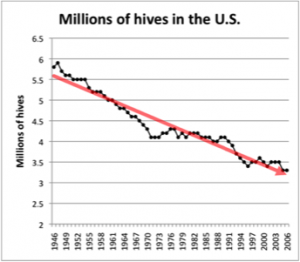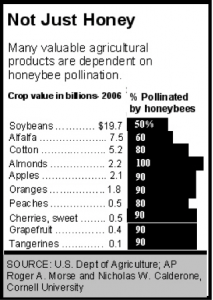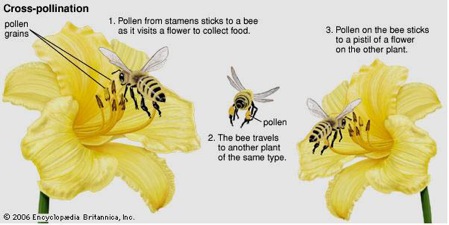Bees are essential pollinators of the many crops that humans eat, such as fruits and vegetables (e.g. cucumber, tomato, apples and berries), nuts and seeds (e.g. almonds), fiber (such as cotton) and hay (alfalfa) that are commonly used to feed livestock.
Pollination occurs when the pollen from the anthers of a flower is transferred to the stigma of the same flower or of another flower. This process results in fertilization that allows the flower to develop seeds and crops. There are several animals, which are known as pollinators, that are responsible for this process and these includes bees, butterflies, birds, and bats. It is estimated that the honey bees pollinate up to 80% of the flowering crops, which constitutes to almost one-third of everything we eat. A study done by the Cornell University estimated that the honey bees annually pollinate up to $14 billion worth of seeds and crops in the U.S (Morse & Calderone, 2010).
Therefore, if these under-appreciated workers of nature disappear, an enormous part of the ecosystem, which includes the insect pollinated plants and other flora and fauna that depends directly or indirectly on these bees, will essentially vanish as well. This will then potentially reduce mankind’s diet to just a little more than a water diet.

The honey bees colonies has decreased from about 5 million in the 1940s to only 2.5 million in recent years.
Astoundingly, it is estimated that over the past six years in the US, over 10 million of beehives has disappeared. Scientists have named this condition the Colony Collapse Disorder (CCD), in which the bees would fly off in search of pollen and nectar but did not return to their colonies, causing the colonies to die off. This behavior among the bees has been occurring throughout the centuries in minimal numbers. However, it is observed that since the 1970s, the bees disappearing have increased drastically and reaching an alarming proportion around 2006.
Though there is no one specific reason that has been found responsible for this bizarre behavior occurring among the honey bees, however, there appears to be several factors that contributes to the declination of the honey bees population.
More information about the Colony Collapse Disorder can be found here.


